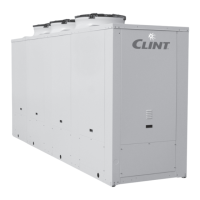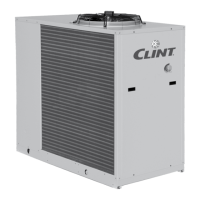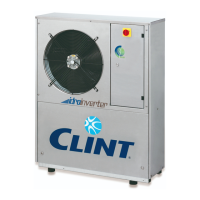21
CHA
motore (1) ed agire con un cacciavite sull’intaglio previsto
sull’albero motore dal lato ventilazione. In caso di bloccaggio
ruotare il cacciavite battendo leggermente su di esso con
un martello (fig. A), rimontare il copriventola.
- Dare tensione e controllare, per la versione trifase, il giusto
senso di rotazione, che, osservando il motore dal lato ven-
tola, dovrà avvenire in senso orario (fig. B). In caso contrario
invertire tra di loro due qualsiasi conduttori di fase.
- Avviata la pompa accertarsi che l’acqua circoli nella
quantità prevista. Per questa verifica ci si può servire
dei manometri (se presenti) installati a monte e a valle
della pompa: la differenza delle due pressioni deve
essere uguale alla perdita di carico dell’impianto,
evaporatore compreso. Per correggere la portata del-
l’acqua agire sul rubinetto posto a valle della pompa.
Per le unità equipaggiate con due pompe, si dovrà
ripetere l’operazione di taratura per ciascuna pompa.
Segnare la posizione di ciascun rubinetto, in quanto, se
chiuso per operazioni di manutenzione, dovrà essere
riposizionato allo stesso modo prima di rimettere in
funzione l’unità.
- Un sistema pratico per la taratura della portata acqua
consiste nella verifica del Δt tra ingresso e uscita nel
momento in cui l'unità lavora a regime (tutti i compres-
sori accesi), la differenza di temperatura dell'acqua
tra ingresso ed uscita deve essere compresa tra 4°
e 6°C. Se è inferiore a 4°C la portata acqua è troppo
elevata: chiudere leggermente il rubinetto di mandata
della pompa. Se è superiore a 6°C, verificare le perdite
di carico sul circuito idraulico.
Attenzione!
Prima di procedere alla messa in funzione
dell’unità, assicurarsi che tutti i pannelli di
chiusura siano al loro posto e siano stati ben
fissati con le apposite viti.
and rotate it. If it blocks, rotate the screwdriver by
gently hitting it with a hammer (fig. A). Then put the
fan cover back.
- Power the unit and check, for the three-phase ver-
sion, the motor rotates clockwise, looking at it from
the fan side (fig. B). If this is not the case, invert any
two phase wires.
- After starting the pump, make sure that the correct
quantity of water is circulating. The pressure gauges
( if fitted) installed upline and downline from the pump
may be used to carry out this check: the difference
between the two pressures must be equal to the pres-
sure drop of the system, including the evaporator. To
adjust the flow of water, turn the valve located down-
line from the pump. For units fitted with two pumps,
both of them must be adjusted. Mark the position of
each valve so that if they are closed for maintenance
operations, they can be moved to the same place
before starting up the unit again.
- To set adequately the water flow, check the water
temperature rise between inlet and outlet when the
units is full load working (all the compressors on ): the
temperature rise should range from 4°C to 6°C. If it is
less than 4°C, the water flow is too high: shut slightly
the pump supply valve. If it exceeds 6°C, check the
water system pressure drops.
Attention!
Before starting up the unit, make sure that
all the external panels are in place and fixed
with screws.
